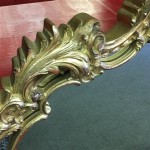Does a Convex Mirror Make Images Smaller?
Convex mirrors, characterized by their outwardly curved reflective surface, possess distinct optical properties that influence the size, orientation, and location of reflected images. Understanding these properties is crucial in various applications, from automotive safety to security surveillance.
Image Size: Always Smaller
A fundamental characteristic of convex mirrors is their ability to produce images smaller than the original object. This reduction in size is a direct consequence of the diverging nature of light rays reflected from the curved surface. As light rays strike the mirror's surface, they reflect outwards, spreading apart. When these diverging rays are traced back, they appear to originate from a point behind the mirror, forming a virtual image. This virtual image is always smaller than the actual object, regardless of the object's distance from the mirror.
Virtual Images: Always Formed
Unlike concave mirrors, which can produce both real and virtual images depending on the object's position, convex mirrors exclusively form virtual images. A virtual image is an image that appears to be located behind the mirror's surface. It cannot be projected onto a screen, as it is not formed by the actual convergence of light rays. The virtual nature of images formed by convex mirrors is a direct result of the diverging reflection of light.
Field of View: Wider Than Plane Mirrors
Convex mirrors offer a significantly wider field of view compared to plane mirrors of similar size. This wider perspective results from the outward curvature of the mirror's surface, which allows it to reflect light rays from a broader range of angles. This characteristic makes convex mirrors invaluable in applications requiring a panoramic view, such as security surveillance, rearview mirrors in vehicles, and hallway monitors in buildings.
Object Distance and Image Size
While the image formed by a convex mirror is always smaller than the object, the degree of size reduction is influenced by the object's distance from the mirror. As the object moves closer to the mirror, the virtual image also moves closer to the mirror and increases slightly in size. Conversely, as the object moves farther away, the virtual image recedes further behind the mirror and diminishes in size. However, regardless of the distance, the image remains smaller than the object.
Upright Images: Always Erect
Images formed by convex mirrors are always upright or erect. This means the image's orientation is the same as the object's orientation. This consistent upright orientation is a crucial factor in the use of convex mirrors as rearview mirrors in vehicles. Drivers can easily interpret the scene behind them without the image being inverted or flipped.
Applications of Convex Mirrors
The unique optical properties of convex mirrors make them highly suitable for a variety of applications. Their ability to provide a wide field of view and smaller, upright images contributes to enhanced safety and security in various contexts. Common applications include:
- Rearview mirrors in vehicles: The wider field of view allows drivers to see a larger portion of the road behind them.
- Security mirrors in shops and buildings: The wide angle enables surveillance of larger areas, deterring theft and enhancing security.
- Traffic mirrors at blind corners: These mirrors improve visibility at intersections and sharp turns, reducing the risk of accidents.
- Hallway mirrors in schools and hospitals: Convex mirrors offer a broader view of hallways, improving safety and monitoring.
Understanding the Image Formation Process
The formation of smaller, virtual, and upright images in a convex mirror can be understood through ray diagrams. By tracing the path of two key rays – one parallel to the principal axis and one directed towards the center of curvature – the point of apparent intersection behind the mirror can be determined. This point of intersection represents the location of the virtual image. The diverging nature of the reflected rays ensures the image is always virtual and smaller than the object.
How Do Reflections From Convex Mirrors Make Objects Appear Smaller Quora
Objects In The Mirror Are Actually Images Article Khan Academy
Objects In The Mirror Are Actually Images Article Khan Academy
Can A Convex Mirror Form Magnified Image Quora
Why Is A Convex Mirror Image Obtained Smaller Than The Original Quora

Convex Mirrors And Objects Larger Than The Mirror

Convex Mirrors And Objects Larger Than The Mirror

Convex Mirror Image Formation Conditions Ray Diagram Uses

Question Identifying The Maximum Size Of An Image Produced By A Convex Mirror Nagwa
Objects In The Mirror Are Actually Images Article Khan Academy








